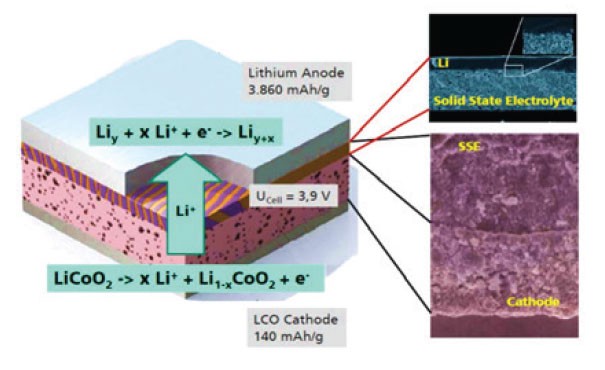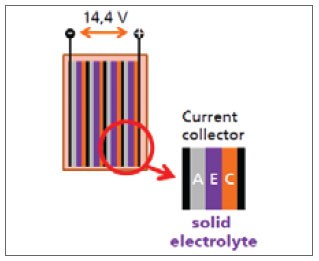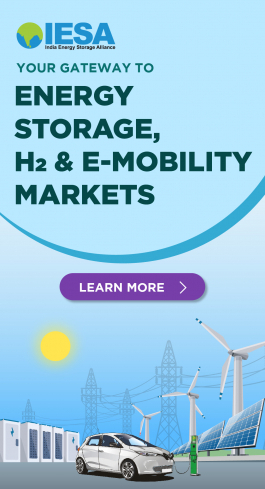Solid state batteries: A giant leap in energy density
As we move in the direction of electrification of transportation, a stronger need for more compact and light weight batteries is emerging. This is because it allows the EV developer to offer a longer driving range, leading to improved customer satisfaction. Solid state batteries (SSBs) are a step in this direction that offer a giant leap in the energy density in terms of weight (Wh/kg) as well as volume (Wh/L) over the existing state-of-the-art Li-ion batteries.
What is a solid state battery?
Before we delve deeper into the discussion, it is important to understand that SSB is not a new battery chemistry. In fact, this category of storage devices have a lot in common with Li-ion batteries with one critical difference. Currently, all components of a traditional Li-ion cell are solid, except the electrolyte which is a liquid. In case of SSBs, the liquid electrolyte+separator is replaced by a solid electrolyte making the entire battery solid. Hence the name solid state batteries.
Types of solid state batteries
'Solid electrolytes' is an umbrella term used to describe three broad categories namely, polymer electrolytes, gel electrolytes and solid ceramic electrolytes. Polymer and gel electrolytes are further along in the commercialization journey (TRL= 6-7), where commercial prototypes are ready along with a small production capacity (pilot production). Solid ceramic electrolytes are in an initial stage of development (TRL = 4-5). The prototypes are under testing, and development and pilot production is being envisioned.
A common characteristic of polymer and ceramic electrolytes is that their optimum performance is obtained at a higher-than-ambient temperature of operation. This is because in the solid state, the itinerant Li+ (lithium ion) is less mobile compared to the liquid state. It can be intuitively understood since atoms and molecules in the solid state are more tightly held than in the liquid state. Polymer electrolytes such as PEO (polyethylene oxide) exhibit usable conductivity in the temperature range of 60-80oC. A French company by the name of Blue Solutions is currently manufacturing and deploying these batteries. Examples of companies using solid ceramic electrolytes are Solid Energy, Sion Power, Solid Power, Quantum scape and Prologium.
The elevated temperature of operation could actually be an advantage for tropical countries such as India where the ambient temperatures are generally high. Normally, the battery packs in larger EVs (4W, heavy vehicles) need to be equipped with complex cooling systems which adds weight and volume. This could be avoided by using SSBs. The use of solid electrolytes in batteries is new only in case of Li-ion batteries. However, solid electrolytes are commonly used in other prominent technologies such as NAS batteries (β-Alumina), Vanadium redox flow batteries (Nafion membrane), PEM Fuel cells (Nafion membrane), SOFCs (YSZ electrolyte) and in lead acid batteries (Gel type).
Performance advantage of SSBs
The reason for considering solid electrolytes are many and it leads to several performance improvements. Solid electrolytes are stable in the presence of lithium metal, which opens the door for using lithium as the anode material instead of graphite. This is an exciting prospect because lithium (3600 mAh/g) is 10X lighter than the graphite anode (372 mAh/g) which is used in almost all Li-ion batteries. It is good to remember here that the anode and the cathode are the only two active components in any battery. They are responsible for the storage of energy while all other components are simply facilitators for the charge and discharge of this energy. So any weight reduction of the active materials leads to a substantial increase in the energy density of the batteries.
Additionally, solid electrolytes also have a wide operating window, which means they are compatible with high voltage cathodes. High voltage cathodes are those which have an operating nominal voltage of > 4.4V. This might seem like a small difference, but the operating voltage has a very large impact on the energy density. This is clear by comparing the energy density of LTO cells (70-90 Wh/kg), LFP cells (120-140 Wh/kg) and NMC cells (240-260 Wh/kg) which have nominal voltages of 2.3V, 3.4V and 3.8V respectively.
A combination of the Li-anode and high voltage cathode is expected to give an approximately 30 percent boost to energy density and allow cell level energy density to reach 450-500 Wh/kg and 1000-1200 Wh/L.
Design Improvements: High voltage cells
In addition to these two parameters, which clearly impact the weight and volume of the cell, SSBs also open up a new avenue for re-inventing cell design. We know that irrespective of which Li-ion cell you are using, its nominal voltage is always between 3 to 4 Volts. This is the voltage of a single cell. By using a solid electrolyte, it becomes possible to layer up multiple single cells in series to have a cell with a much larger voltage. Such type of cell design is called a bipolar design and it is currently in the initial development stage for Li-ion batteries.
However, this concept has already been applied to and is the primary design in case of flow batteries (zinc bromine and vanadium redox) and all types of fuel cells (PEMFCs, SOFCs, PAFCs and MCFCs). There are efforts to also implement bipolar design for lead acid batteries by a company called Gridtential. Such design in Li-ion technology can permit cells which have much higher voltages such as 18V, 24V and 48V. This will not only simplify battery pack design but also open up new applications where single cells with high voltages may be essential.
Challenges and opportunities for performance improvement
There are some challenges which still need to be overcome in SSBs. One of the most important ones is the cycle life. As this is a new technology currently under development, their cycle life is quite low (200 - 500 cycles) and still needs to be improved significantly for it to be suitable for standard e-mobility applications like e2W, e3W, e4W and heavy vehicles.
The other challenge is regarding the scale of manufacturing. Most SSB companies are currently at the pilot manufacturing scale, which means they are capable of producing several hundred cells a day. At this scale of manufacturing, the production costs are very high since economies of scale have not been achieved. The good part is that SSBs will be able to leverage a lot of manufacturing equipment from Li-ion batteries due to the mutual similarities in cell design, but they will also need to develop new equipment for the electrode and electrolyte stacking. Such developments take anywhere between 5-10 years to reach GWh scale of manufacturing.
The good part is that there are several niche applications where the extreme lightweight characteristic of SSBs is absolutely essential, while the initial high cost and low cycle life may not be much of a barrier. It is important to point out here that rechargeable cells with 450+ Wh/kg have so far not been possible. So, this new development is bound to enable some new applications otherwise considered improbable. The most important of these is for UAVs and drones where the weight reduction of the battery translates directly to longer flying time.
Battery powered drones with a 1+ hour flying time will enable greater use for agricultural monitoring, cinematography, delivery, logistics and surveillance. Such lightweight batteries have already enabled the use of solar powered weather drones, which remain airborne for a period of 6 months at a time. Another application which is being developed for remote areas is to use drones for delivery of medicines where there are no driveable roads. Similarly, fast delivery of AEDs (defibrillators) to crowded urban locations may also become viable. In the medical world, swalloable capsules are being explored as an alternative to uncomfortable endoscopy procedures.
Everytime a leap in performance of any engineering system is achieved, it propels the development of new applications via the efforts of dreamers and visionaries. To some extent, we already know what impact such batteries would have, while many new applications will emerge as their production increases and costs are reduced.






















